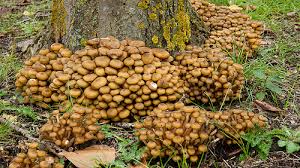Fungi
eat or be eaten !
Having just
got back from a Tree Safety Management training course and recently hosted a
fungal foray guided walk , fungi are featuring prominently in my worklife at
the moment . They are also behind some big challenges facing the National Trust
in the Lake District .
Autumn days of mellow fruitfulness
It is at this
time of year that the Ranger team are out and about checking our trees for
issues that might make them a risk to our visitors or property. We deliberately choose this time of year because
this is the time that many fungi are fruiting and are making themselves visible
around the base or trunk of the tree. For some trees next to busy roads, paths or houses , the presence of certain types of
fungi can indicate a problem that might make the tree unsafe over time and
because of this they may need some work doing to make them safe . This can mean
the removal of a single branch , the removal of several branches to reduce the
weight or height of a tree or in extreme cases,
and as a last resort, the felling
of the whole tree. We always try to do the minimum amount of work to a tree to
make it safe.
 |
| Honey Fungus at the base of a tree can be bad news . |
Fungi are an essential
part of the ecosystem, many of our plants and animals , including humans , are
dependent on the success of different
forms of fungi for their survival . Many plants and trees rely on tiny networks
of fungi in the soil for the absorbtion of
minerals and nutrients . Fungi assist the recycling process by rotting
down vegetation, without them we would be standing on a mountain of debris from
years of growth.
Wet Rot at Townend
 |
| Wet rot in an oak beam at Townend |
The success of
certain types of fungi can be bad news though. Imagine what it feels like to press against a
400 year old solid oak beam and feel it crumble beneath your fingers. That was
just what we were faced with at Townend House
( Troutbeck ) when we scraped away the top layer of render to check the
condition of the beams holding up this grade 1 listed farmhouse. The discovery of this wet rot means a lot of
expensive work over the winter to find
,repair or replace all the damaged beams potentially costing £100,000.
Fungal Foray
I recently agreed (
actually someone volunteered me ! ) to host a ‘Foraging with the Farringtons
‘ walk around Harrowslack on the west
shore of Lake Windermere for the Hawkshead
Womens Institute . In previous years , in the company of a knowledgeable expert we have found 95 species of fungi some edible some not .
This has been a cold year in the lakes and the fungi were being a bit shy ,
after rummaging around I managed to gather 5 species on our walk some nice Chanterelles, a couple of Birch
Boletes , Yellow Russulas , a small
puffball and a hedgehog fungus all
pretty easy to identify and good to eat . Always use a good ID book or better
still go on a walk with an expert.
So fungi are very much a part of life in the National Trust
at the moment sometimes dangerous,
sometimes delicious , sometimes downright costly , but always
interesting .
Paul Farrington - Area Ranger South Lakes


No comments:
Post a Comment